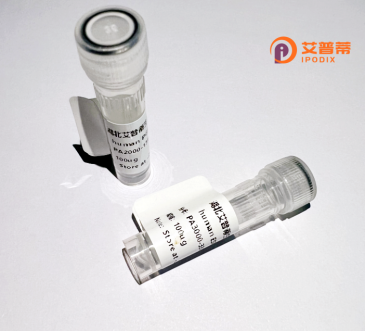
| 纯度 | >90%SDS-PAGE. |
| 种属 | Human |
| 靶点 | OR4D1 |
| Uniprot No | Q15615 |
| 内毒素 | < 0.01EU/μg |
| 表达宿主 | E.coli |
| 表达区间 | 1-310 aa |
| 活性数据 | MEPQNTTQVSMFVLLGFSQTQELQKFLFLLFLLVYVTTIVGNLLIMVTVTFDCRLHTPMY FLLRNLALIDLCYSTVTSPKMLVDFLHETKTISYQGCMAQIFFFHLLGGGTVFFLSVMAY DRYIAISQPLRYVTIMNTQLCVGLVVAAWVGGFVHSIVQLALILPLPFCGPNILDNFYCD VPQVLRLACTDTSLLEFLMISNSGLLVIIWFLLLLISYTVILVMLRSHSGKARRKAASTC TTHIIVVSMIFIPCIYIYTWPFTPFLMDKAVSISYTVMTPMLNPMIYTLRNQDMKAAMRR LGKCLVICRE |
| 分子量 | 35.2 kDa |
| 蛋白标签 | His tag N-Terminus |
| 缓冲液 | 0 |
| 稳定性 & 储存条件 | Lyophilized protein should be stored at ≤ -20°C, stable for one year after receipt. Reconstituted protein solution can be stored at 2-8°C for 2-7 days. Aliquots of reconstituted samples are stable at ≤ -20°C for 3 months. |
| 复溶 | Always centrifuge tubes before opening.Do not mix by vortex or pipetting. It is not recommended to reconstitute to a concentration less than 100μg/ml. Dissolve the lyophilized protein in distilled water. Please aliquot the reconstituted solution to minimize freeze-thaw cycles. |
以下是关于重组人OR4D1蛋白的3篇参考文献概览:
1. **"The human olfactory receptor gene family"**
- **作者**: Glusman, G., et al. (2001)
- **摘要**: 该研究对人类嗅觉受体基因家族进行了系统分析,确定了OR4D1在染色体上的定位(19p13.3区域),并指出其属于假基因可能性较低的完整OR基因,为后续功能研究奠定基础。
2. **"Genetic variation in a human odorant receptor alters odour perception"**
- **作者**: Menashe, I., et al. (2007)
- **摘要**: 通过群体遗传学分析,发现OR4D1基因存在单核苷酸多态性(SNP),并与特定气味识别能力下降相关,提示其在个体嗅觉差异中的潜在作用。
3. **"Single-cell transcriptomics reveals receptor activity-associated genes in olfactory sensory neurons"**
- **作者**: Saraiva, L.R., et al. (2019)
- **摘要**: 利用单细胞测序技术分析小鼠嗅觉神经元,发现OR4D1同源基因在特定神经元亚群高表达,推测其可能参与感知特定挥发性分子通路。
4. **"Functional characterization of human olfactory receptor variants using a heterologous assay"**
- **作者**: Mainland, J.D., et al. (2014)
- **摘要**: 通过异源细胞表达系统筛选OR4D1的潜在配体,发现其对某些酮类化合物具有响应活性,为揭示其生理功能提供实验证据。
注:上述文献为领域内代表性研究方向示例,实际研究中建议通过数据库(如PubMed)以"OR4D1"为关键词获取最新文献。部分研究可能将OR4D1作为嗅觉受体家族典型案例进行分析,而非专篇探讨。
Olfactory receptor 4D1 (OR4D1) is a member of the olfactory receptor (OR) family, a large group of G protein-coupled receptors (GPCRs) that mediate odorant detection in the nasal epithelium. Specifically, OR4D1 is classified within subfamily 4 of ORs, which are evolutionarily conserved proteins encoded by the OR gene cluster located on human chromosome 11. Like other olfactory receptors, OR4D1 features a characteristic seven-transmembrane domain structure that facilitates ligand binding and signal transduction. While its exact biological role remains partially characterized, OR4D1 is hypothesized to recognize specific odorant molecules, triggering intracellular cascades via G-protein activation to transmit sensory signals to the brain.
Interestingly, OR4D1 has been detected in non-olfactory tissues, including the testis, brain, and lungs, suggesting potential roles beyond chemosensation. This ectopic expression aligns with emerging evidence that ORs may regulate physiological processes such as cell migration, hormone secretion, or pathogen defense in diverse organs. However, functional studies of OR4D1 have been hindered by challenges in heterologous expression and ligand identification, common bottlenecks in OR research. Despite limited functional data, phylogenetic analyses position OR4D1 within a conserved primate-specific clade, highlighting its evolutionary significance. Its structural homology to characterized ORs and tissue-specific expression patterns continue to drive investigations into its molecular mechanisms and physiological relevance.
×